Dissertation: Nutritional Interventions for Type 2 Diabetes in UK BAME
VerifiedAdded on 2020/05/16
|16
|4009
|44
Project
AI Summary
This dissertation proposal outlines a literature-based study investigating the effectiveness of nutritional interventions in reducing type 2 diabetes among Black, Asian, and Minority Ethnic (BAME) populations in the UK. The research question focuses on the efficacy of these interventions, with a null hypothesis suggesting their preventative or reductionary impact on type 2 diabetes within the BAME community. The study acknowledges the high prevalence of type 2 diabetes in BAME individuals, linking it to dietary habits and lifestyle factors. The methodology involves a systematic review of literature, specifically focusing on randomised controlled trials (RCTs) conducted between 2010 and 2017, and adhering to specific inclusion and exclusion criteria to ensure the quality and relevance of the selected studies. The PICO tool is used to define the population, intervention, control, and outcomes. The search strategy will use key search terms in databases such as PubMed, BND, Medline, and CINAHL. The proposal highlights the advantages of a literature review approach, such as saving time and resources, while acknowledging its limitations, including the lack of new findings and control over primary data quality.
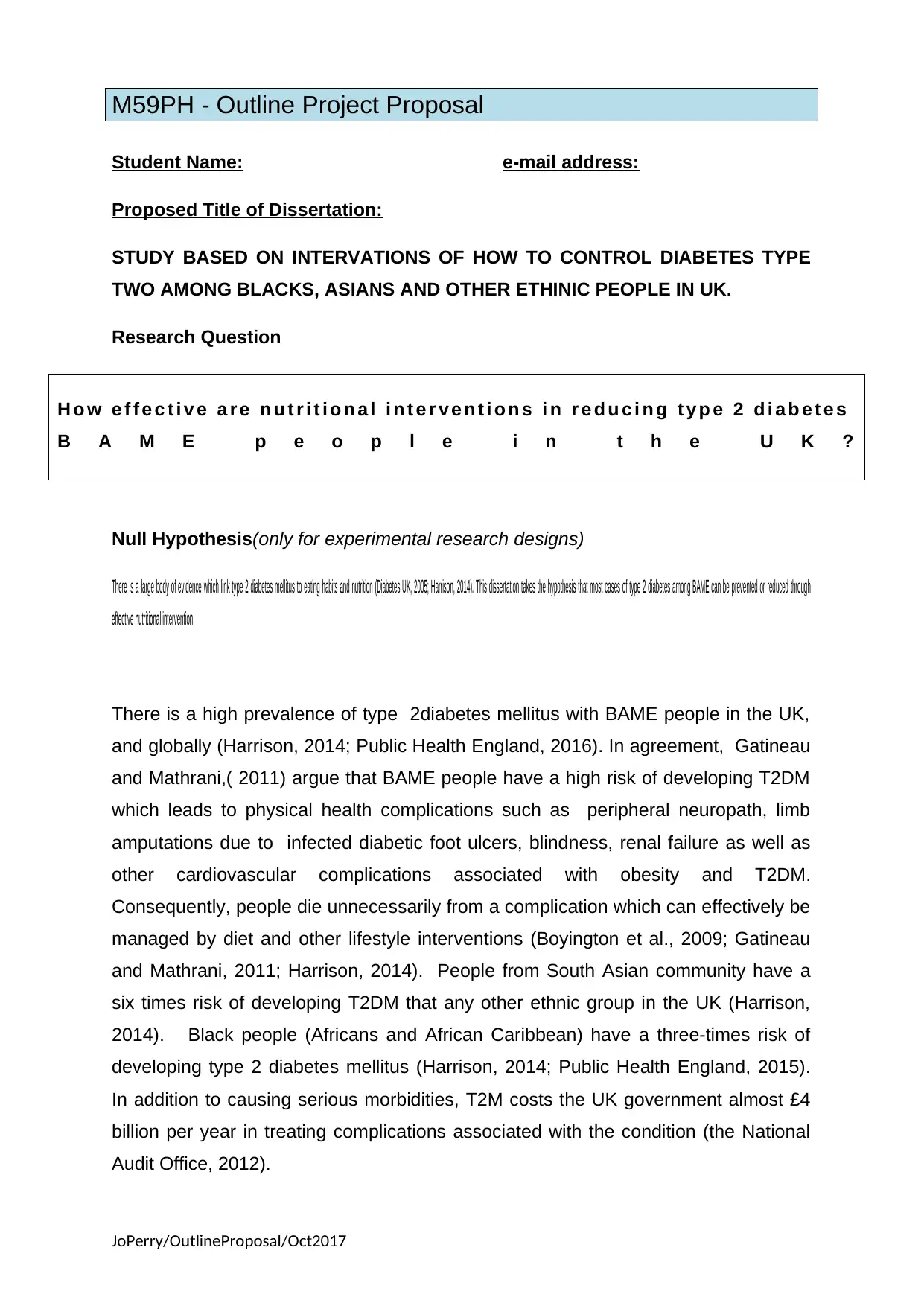
M59PH - Outline Project Proposal
Student Name: e-mail address:
Proposed Title of Dissertation:
STUDY BASED ON INTERVATIONS OF HOW TO CONTROL DIABETES TYPE
TWO AMONG BLACKS, ASIANS AND OTHER ETHINIC PEOPLE IN UK.
Research Question
H o w e f f e c t i v e a r e n u t r i t i o n a l i n t e r v e n t i o n s i n r e d u c i n g t y p e 2 d i a b e t e s
B A M E p e o p l e i n t h e U K ?
Null Hypothesis(only for experimental research designs)
There is a large body of evidence which link type 2 diabetes mellitus to eating habits and nutrition (Diabetes UK, 2005; Harrison, 2014). This dissertation takes the hypothesis that most cases of type 2 diabetes among BAME can be prevented or reduced through
effective nutritional intervention.
There is a high prevalence of type 2diabetes mellitus with BAME people in the UK,
and globally (Harrison, 2014; Public Health England, 2016). In agreement, Gatineau
and Mathrani,( 2011) argue that BAME people have a high risk of developing T2DM
which leads to physical health complications such as peripheral neuropath, limb
amputations due to infected diabetic foot ulcers, blindness, renal failure as well as
other cardiovascular complications associated with obesity and T2DM.
Consequently, people die unnecessarily from a complication which can effectively be
managed by diet and other lifestyle interventions (Boyington et al., 2009; Gatineau
and Mathrani, 2011; Harrison, 2014). People from South Asian community have a
six times risk of developing T2DM that any other ethnic group in the UK (Harrison,
2014). Black people (Africans and African Caribbean) have a three-times risk of
developing type 2 diabetes mellitus (Harrison, 2014; Public Health England, 2015).
In addition to causing serious morbidities, T2M costs the UK government almost £4
billion per year in treating complications associated with the condition (the National
Audit Office, 2012).
JoPerry/OutlineProposal/Oct2017
Student Name: e-mail address:
Proposed Title of Dissertation:
STUDY BASED ON INTERVATIONS OF HOW TO CONTROL DIABETES TYPE
TWO AMONG BLACKS, ASIANS AND OTHER ETHINIC PEOPLE IN UK.
Research Question
H o w e f f e c t i v e a r e n u t r i t i o n a l i n t e r v e n t i o n s i n r e d u c i n g t y p e 2 d i a b e t e s
B A M E p e o p l e i n t h e U K ?
Null Hypothesis(only for experimental research designs)
There is a large body of evidence which link type 2 diabetes mellitus to eating habits and nutrition (Diabetes UK, 2005; Harrison, 2014). This dissertation takes the hypothesis that most cases of type 2 diabetes among BAME can be prevented or reduced through
effective nutritional intervention.
There is a high prevalence of type 2diabetes mellitus with BAME people in the UK,
and globally (Harrison, 2014; Public Health England, 2016). In agreement, Gatineau
and Mathrani,( 2011) argue that BAME people have a high risk of developing T2DM
which leads to physical health complications such as peripheral neuropath, limb
amputations due to infected diabetic foot ulcers, blindness, renal failure as well as
other cardiovascular complications associated with obesity and T2DM.
Consequently, people die unnecessarily from a complication which can effectively be
managed by diet and other lifestyle interventions (Boyington et al., 2009; Gatineau
and Mathrani, 2011; Harrison, 2014). People from South Asian community have a
six times risk of developing T2DM that any other ethnic group in the UK (Harrison,
2014). Black people (Africans and African Caribbean) have a three-times risk of
developing type 2 diabetes mellitus (Harrison, 2014; Public Health England, 2015).
In addition to causing serious morbidities, T2M costs the UK government almost £4
billion per year in treating complications associated with the condition (the National
Audit Office, 2012).
JoPerry/OutlineProposal/Oct2017
Paraphrase This Document
Need a fresh take? Get an instant paraphrase of this document with our AI Paraphraser
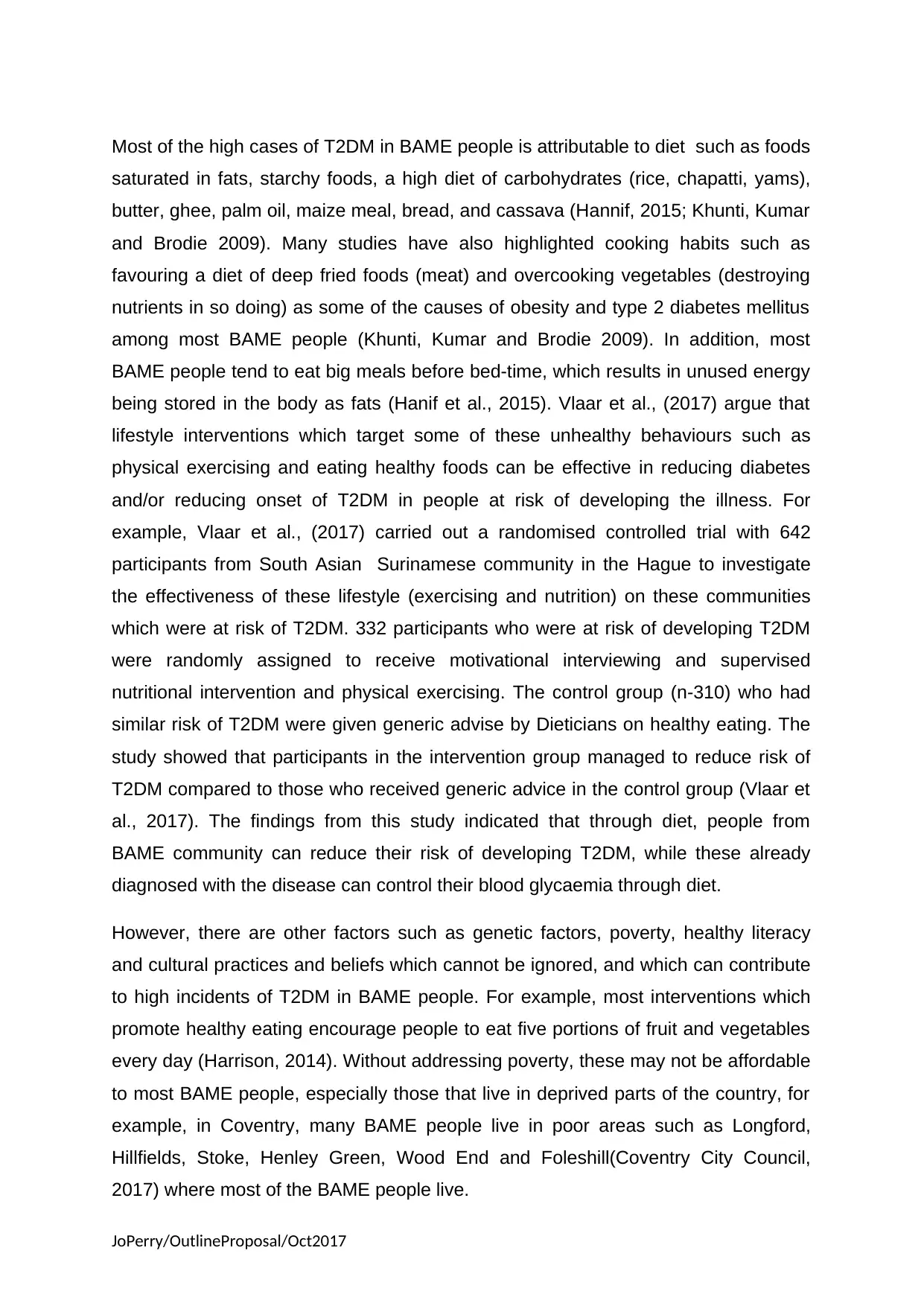
Most of the high cases of T2DM in BAME people is attributable to diet such as foods
saturated in fats, starchy foods, a high diet of carbohydrates (rice, chapatti, yams),
butter, ghee, palm oil, maize meal, bread, and cassava (Hannif, 2015; Khunti, Kumar
and Brodie 2009). Many studies have also highlighted cooking habits such as
favouring a diet of deep fried foods (meat) and overcooking vegetables (destroying
nutrients in so doing) as some of the causes of obesity and type 2 diabetes mellitus
among most BAME people (Khunti, Kumar and Brodie 2009). In addition, most
BAME people tend to eat big meals before bed-time, which results in unused energy
being stored in the body as fats (Hanif et al., 2015). Vlaar et al., (2017) argue that
lifestyle interventions which target some of these unhealthy behaviours such as
physical exercising and eating healthy foods can be effective in reducing diabetes
and/or reducing onset of T2DM in people at risk of developing the illness. For
example, Vlaar et al., (2017) carried out a randomised controlled trial with 642
participants from South Asian Surinamese community in the Hague to investigate
the effectiveness of these lifestyle (exercising and nutrition) on these communities
which were at risk of T2DM. 332 participants who were at risk of developing T2DM
were randomly assigned to receive motivational interviewing and supervised
nutritional intervention and physical exercising. The control group (n-310) who had
similar risk of T2DM were given generic advise by Dieticians on healthy eating. The
study showed that participants in the intervention group managed to reduce risk of
T2DM compared to those who received generic advice in the control group (Vlaar et
al., 2017). The findings from this study indicated that through diet, people from
BAME community can reduce their risk of developing T2DM, while these already
diagnosed with the disease can control their blood glycaemia through diet.
However, there are other factors such as genetic factors, poverty, healthy literacy
and cultural practices and beliefs which cannot be ignored, and which can contribute
to high incidents of T2DM in BAME people. For example, most interventions which
promote healthy eating encourage people to eat five portions of fruit and vegetables
every day (Harrison, 2014). Without addressing poverty, these may not be affordable
to most BAME people, especially those that live in deprived parts of the country, for
example, in Coventry, many BAME people live in poor areas such as Longford,
Hillfields, Stoke, Henley Green, Wood End and Foleshill(Coventry City Council,
2017) where most of the BAME people live.
JoPerry/OutlineProposal/Oct2017
saturated in fats, starchy foods, a high diet of carbohydrates (rice, chapatti, yams),
butter, ghee, palm oil, maize meal, bread, and cassava (Hannif, 2015; Khunti, Kumar
and Brodie 2009). Many studies have also highlighted cooking habits such as
favouring a diet of deep fried foods (meat) and overcooking vegetables (destroying
nutrients in so doing) as some of the causes of obesity and type 2 diabetes mellitus
among most BAME people (Khunti, Kumar and Brodie 2009). In addition, most
BAME people tend to eat big meals before bed-time, which results in unused energy
being stored in the body as fats (Hanif et al., 2015). Vlaar et al., (2017) argue that
lifestyle interventions which target some of these unhealthy behaviours such as
physical exercising and eating healthy foods can be effective in reducing diabetes
and/or reducing onset of T2DM in people at risk of developing the illness. For
example, Vlaar et al., (2017) carried out a randomised controlled trial with 642
participants from South Asian Surinamese community in the Hague to investigate
the effectiveness of these lifestyle (exercising and nutrition) on these communities
which were at risk of T2DM. 332 participants who were at risk of developing T2DM
were randomly assigned to receive motivational interviewing and supervised
nutritional intervention and physical exercising. The control group (n-310) who had
similar risk of T2DM were given generic advise by Dieticians on healthy eating. The
study showed that participants in the intervention group managed to reduce risk of
T2DM compared to those who received generic advice in the control group (Vlaar et
al., 2017). The findings from this study indicated that through diet, people from
BAME community can reduce their risk of developing T2DM, while these already
diagnosed with the disease can control their blood glycaemia through diet.
However, there are other factors such as genetic factors, poverty, healthy literacy
and cultural practices and beliefs which cannot be ignored, and which can contribute
to high incidents of T2DM in BAME people. For example, most interventions which
promote healthy eating encourage people to eat five portions of fruit and vegetables
every day (Harrison, 2014). Without addressing poverty, these may not be affordable
to most BAME people, especially those that live in deprived parts of the country, for
example, in Coventry, many BAME people live in poor areas such as Longford,
Hillfields, Stoke, Henley Green, Wood End and Foleshill(Coventry City Council,
2017) where most of the BAME people live.
JoPerry/OutlineProposal/Oct2017
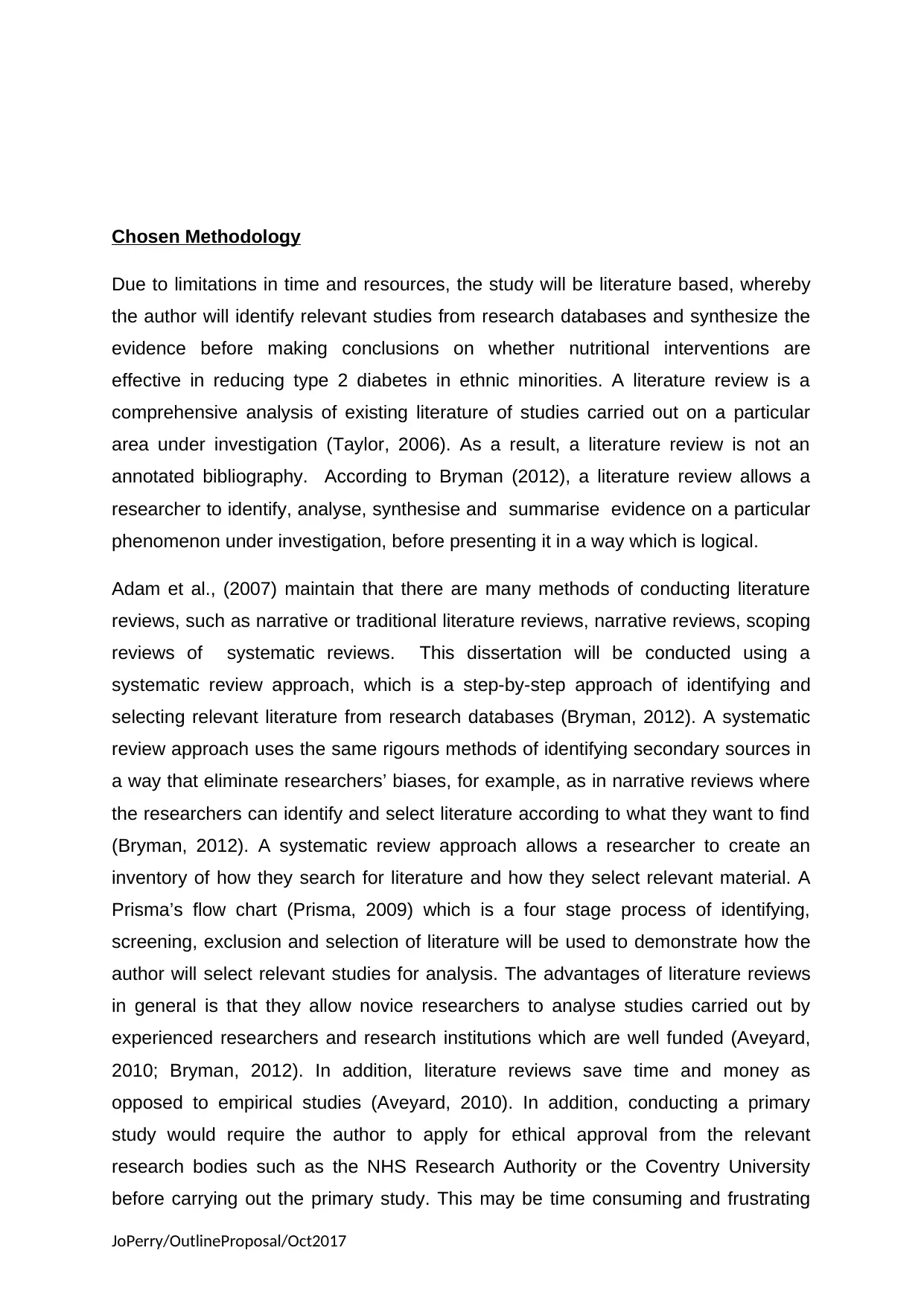
Chosen Methodology
Due to limitations in time and resources, the study will be literature based, whereby
the author will identify relevant studies from research databases and synthesize the
evidence before making conclusions on whether nutritional interventions are
effective in reducing type 2 diabetes in ethnic minorities. A literature review is a
comprehensive analysis of existing literature of studies carried out on a particular
area under investigation (Taylor, 2006). As a result, a literature review is not an
annotated bibliography. According to Bryman (2012), a literature review allows a
researcher to identify, analyse, synthesise and summarise evidence on a particular
phenomenon under investigation, before presenting it in a way which is logical.
Adam et al., (2007) maintain that there are many methods of conducting literature
reviews, such as narrative or traditional literature reviews, narrative reviews, scoping
reviews of systematic reviews. This dissertation will be conducted using a
systematic review approach, which is a step-by-step approach of identifying and
selecting relevant literature from research databases (Bryman, 2012). A systematic
review approach uses the same rigours methods of identifying secondary sources in
a way that eliminate researchers’ biases, for example, as in narrative reviews where
the researchers can identify and select literature according to what they want to find
(Bryman, 2012). A systematic review approach allows a researcher to create an
inventory of how they search for literature and how they select relevant material. A
Prisma’s flow chart (Prisma, 2009) which is a four stage process of identifying,
screening, exclusion and selection of literature will be used to demonstrate how the
author will select relevant studies for analysis. The advantages of literature reviews
in general is that they allow novice researchers to analyse studies carried out by
experienced researchers and research institutions which are well funded (Aveyard,
2010; Bryman, 2012). In addition, literature reviews save time and money as
opposed to empirical studies (Aveyard, 2010). In addition, conducting a primary
study would require the author to apply for ethical approval from the relevant
research bodies such as the NHS Research Authority or the Coventry University
before carrying out the primary study. This may be time consuming and frustrating
JoPerry/OutlineProposal/Oct2017
Due to limitations in time and resources, the study will be literature based, whereby
the author will identify relevant studies from research databases and synthesize the
evidence before making conclusions on whether nutritional interventions are
effective in reducing type 2 diabetes in ethnic minorities. A literature review is a
comprehensive analysis of existing literature of studies carried out on a particular
area under investigation (Taylor, 2006). As a result, a literature review is not an
annotated bibliography. According to Bryman (2012), a literature review allows a
researcher to identify, analyse, synthesise and summarise evidence on a particular
phenomenon under investigation, before presenting it in a way which is logical.
Adam et al., (2007) maintain that there are many methods of conducting literature
reviews, such as narrative or traditional literature reviews, narrative reviews, scoping
reviews of systematic reviews. This dissertation will be conducted using a
systematic review approach, which is a step-by-step approach of identifying and
selecting relevant literature from research databases (Bryman, 2012). A systematic
review approach uses the same rigours methods of identifying secondary sources in
a way that eliminate researchers’ biases, for example, as in narrative reviews where
the researchers can identify and select literature according to what they want to find
(Bryman, 2012). A systematic review approach allows a researcher to create an
inventory of how they search for literature and how they select relevant material. A
Prisma’s flow chart (Prisma, 2009) which is a four stage process of identifying,
screening, exclusion and selection of literature will be used to demonstrate how the
author will select relevant studies for analysis. The advantages of literature reviews
in general is that they allow novice researchers to analyse studies carried out by
experienced researchers and research institutions which are well funded (Aveyard,
2010; Bryman, 2012). In addition, literature reviews save time and money as
opposed to empirical studies (Aveyard, 2010). In addition, conducting a primary
study would require the author to apply for ethical approval from the relevant
research bodies such as the NHS Research Authority or the Coventry University
before carrying out the primary study. This may be time consuming and frustrating
JoPerry/OutlineProposal/Oct2017
⊘ This is a preview!⊘
Do you want full access?
Subscribe today to unlock all pages.

Trusted by 1+ million students worldwide
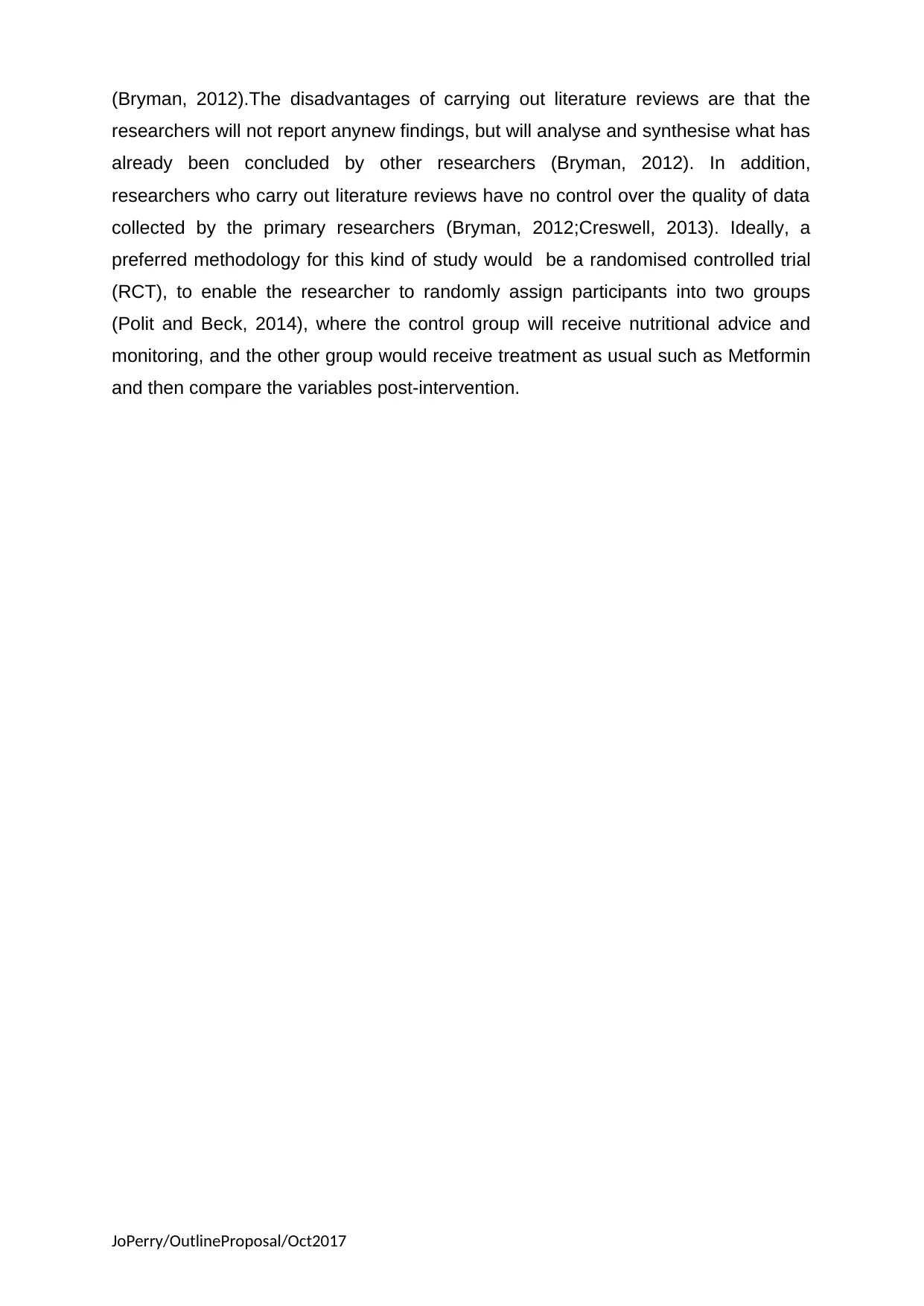
(Bryman, 2012).The disadvantages of carrying out literature reviews are that the
researchers will not report anynew findings, but will analyse and synthesise what has
already been concluded by other researchers (Bryman, 2012). In addition,
researchers who carry out literature reviews have no control over the quality of data
collected by the primary researchers (Bryman, 2012;Creswell, 2013). Ideally, a
preferred methodology for this kind of study would be a randomised controlled trial
(RCT), to enable the researcher to randomly assign participants into two groups
(Polit and Beck, 2014), where the control group will receive nutritional advice and
monitoring, and the other group would receive treatment as usual such as Metformin
and then compare the variables post-intervention.
JoPerry/OutlineProposal/Oct2017
researchers will not report anynew findings, but will analyse and synthesise what has
already been concluded by other researchers (Bryman, 2012). In addition,
researchers who carry out literature reviews have no control over the quality of data
collected by the primary researchers (Bryman, 2012;Creswell, 2013). Ideally, a
preferred methodology for this kind of study would be a randomised controlled trial
(RCT), to enable the researcher to randomly assign participants into two groups
(Polit and Beck, 2014), where the control group will receive nutritional advice and
monitoring, and the other group would receive treatment as usual such as Metformin
and then compare the variables post-intervention.
JoPerry/OutlineProposal/Oct2017
Paraphrase This Document
Need a fresh take? Get an instant paraphrase of this document with our AI Paraphraser
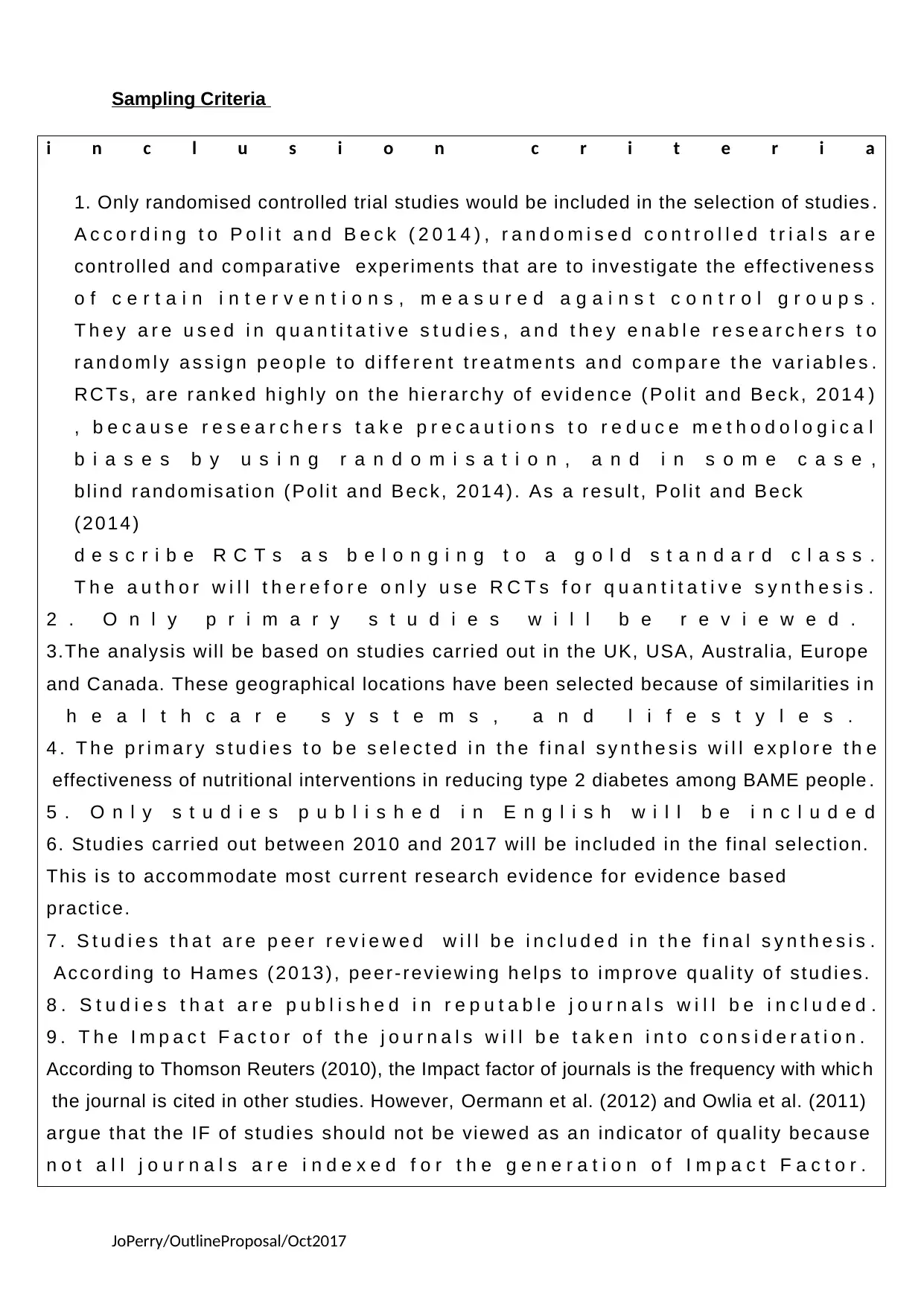
Sampling Criteria
i n c l u s i o n c r i t e r i a
1. Only randomised controlled trial studies would be included in the selection of studies .
A c c o r d i n g t o P o l i t a n d B e c k ( 2 0 1 4 ) , r a n d o m i s e d c o n t r o l l e d t r i a l s a r e
controlled and c omparative experiments that are to investigate the effectivenes s
o f c e r t a i n i n t e r v e n t i o n s , m e a s u r e d a g a i n s t c o n t r o l g r o u p s .
T h e y a r e u s e d i n q u a n t i t a t i v e s t u d i e s , a n d t h e y e n a b l e r e s e a r c h e r s t o
r a n d o m l y a s s i g n p e o p l e t o d i f f e r e n t t r e a t m e n t s a n d c o m p a r e t h e v a r i a b l e s .
R C T s , a r e r a n k e d h i g h l y o n t h e h i e r a r c h y o f e v i d e n c e ( P o l i t a n d B e c k , 2 0 1 4 )
, b e c a u s e r e s e a r c h e r s t a k e p r e c a u t i o n s t o r e d u c e m e t h o d o l o g i c a l
b i a s e s b y u s i n g r a n d o m i s a t i o n , a n d i n s o m e c a s e ,
b l i n d r a n d o m i s a t i o n ( P o l i t a n d B e c k , 2 0 1 4 ) . A s a r e s u l t , P o l i t a n d B e c k
( 2 0 1 4 )
d e s c r i b e R C T s a s b e l o n g i n g t o a g o l d s t a n d a r d c l a s s .
T h e a u t h o r w i l l t h e r e f o r e o n l y u s e R C T s f o r q u a n t i t a t i v e s y n t h e s i s .
2 . O n l y p r i m a r y s t u d i e s w i l l b e r e v i e w e d .
3.The analysis will be based on studies carried out in the UK, USA, Australia, Europe
and Canada. These geographical locations have been selected because of similarities i n
h e a l t h c a r e s y s t e m s , a n d l i f e s t y l e s .
4 . T h e p r i m a r y s t u d i e s t o b e s e l e c t e d i n t h e f i n a l s y n t h e s i s w i l l e x p l o r e t h e
effectiveness of nutritional interventions in reducing type 2 diabetes among BAME people .
5 . O n l y s t u d i e s p u b l i s h e d i n E n g l i s h w i l l b e i n c l u d e d
6. Studies carried out between 2010 and 2017 will be included in the final selection.
This is to accommodate most current research evidence for evidence based
practice.
7 . S t u d i e s t h a t a r e p e e r r e v i e w e d w i l l b e i n c l u d e d i n t h e f i n a l s y n t h e s i s .
A c c o r d i n g t o H a m e s ( 2 0 1 3 ) , p e e r - r e v i e w i n g h e l p s t o i m p r o v e q u a l i t y o f s t u d i e s .
8 . S t u d i e s t h a t a r e p u b l i s h e d i n r e p u t a b l e j o u r n a l s w i l l b e i n c l u d e d .
9 . T h e I m p a c t F a c t o r o f t h e j o u r n a l s w i l l b e t a k e n i n t o c o n s i d e r a t i o n .
According to Thomson Reuters (2010), the Impact factor of journals is the frequency with whic h
the journal is cited in other studies. However, Oermann et al. (2012) and Owlia et al. (2011)
argue that the IF of studies should not be viewed as an indicator of quality because
n o t a l l j o u r n a l s a r e i n d e x e d f o r t h e g e n e r a t i o n o f I m p a c t F a c t o r .
JoPerry/OutlineProposal/Oct2017
i n c l u s i o n c r i t e r i a
1. Only randomised controlled trial studies would be included in the selection of studies .
A c c o r d i n g t o P o l i t a n d B e c k ( 2 0 1 4 ) , r a n d o m i s e d c o n t r o l l e d t r i a l s a r e
controlled and c omparative experiments that are to investigate the effectivenes s
o f c e r t a i n i n t e r v e n t i o n s , m e a s u r e d a g a i n s t c o n t r o l g r o u p s .
T h e y a r e u s e d i n q u a n t i t a t i v e s t u d i e s , a n d t h e y e n a b l e r e s e a r c h e r s t o
r a n d o m l y a s s i g n p e o p l e t o d i f f e r e n t t r e a t m e n t s a n d c o m p a r e t h e v a r i a b l e s .
R C T s , a r e r a n k e d h i g h l y o n t h e h i e r a r c h y o f e v i d e n c e ( P o l i t a n d B e c k , 2 0 1 4 )
, b e c a u s e r e s e a r c h e r s t a k e p r e c a u t i o n s t o r e d u c e m e t h o d o l o g i c a l
b i a s e s b y u s i n g r a n d o m i s a t i o n , a n d i n s o m e c a s e ,
b l i n d r a n d o m i s a t i o n ( P o l i t a n d B e c k , 2 0 1 4 ) . A s a r e s u l t , P o l i t a n d B e c k
( 2 0 1 4 )
d e s c r i b e R C T s a s b e l o n g i n g t o a g o l d s t a n d a r d c l a s s .
T h e a u t h o r w i l l t h e r e f o r e o n l y u s e R C T s f o r q u a n t i t a t i v e s y n t h e s i s .
2 . O n l y p r i m a r y s t u d i e s w i l l b e r e v i e w e d .
3.The analysis will be based on studies carried out in the UK, USA, Australia, Europe
and Canada. These geographical locations have been selected because of similarities i n
h e a l t h c a r e s y s t e m s , a n d l i f e s t y l e s .
4 . T h e p r i m a r y s t u d i e s t o b e s e l e c t e d i n t h e f i n a l s y n t h e s i s w i l l e x p l o r e t h e
effectiveness of nutritional interventions in reducing type 2 diabetes among BAME people .
5 . O n l y s t u d i e s p u b l i s h e d i n E n g l i s h w i l l b e i n c l u d e d
6. Studies carried out between 2010 and 2017 will be included in the final selection.
This is to accommodate most current research evidence for evidence based
practice.
7 . S t u d i e s t h a t a r e p e e r r e v i e w e d w i l l b e i n c l u d e d i n t h e f i n a l s y n t h e s i s .
A c c o r d i n g t o H a m e s ( 2 0 1 3 ) , p e e r - r e v i e w i n g h e l p s t o i m p r o v e q u a l i t y o f s t u d i e s .
8 . S t u d i e s t h a t a r e p u b l i s h e d i n r e p u t a b l e j o u r n a l s w i l l b e i n c l u d e d .
9 . T h e I m p a c t F a c t o r o f t h e j o u r n a l s w i l l b e t a k e n i n t o c o n s i d e r a t i o n .
According to Thomson Reuters (2010), the Impact factor of journals is the frequency with whic h
the journal is cited in other studies. However, Oermann et al. (2012) and Owlia et al. (2011)
argue that the IF of studies should not be viewed as an indicator of quality because
n o t a l l j o u r n a l s a r e i n d e x e d f o r t h e g e n e r a t i o n o f I m p a c t F a c t o r .
JoPerry/OutlineProposal/Oct2017
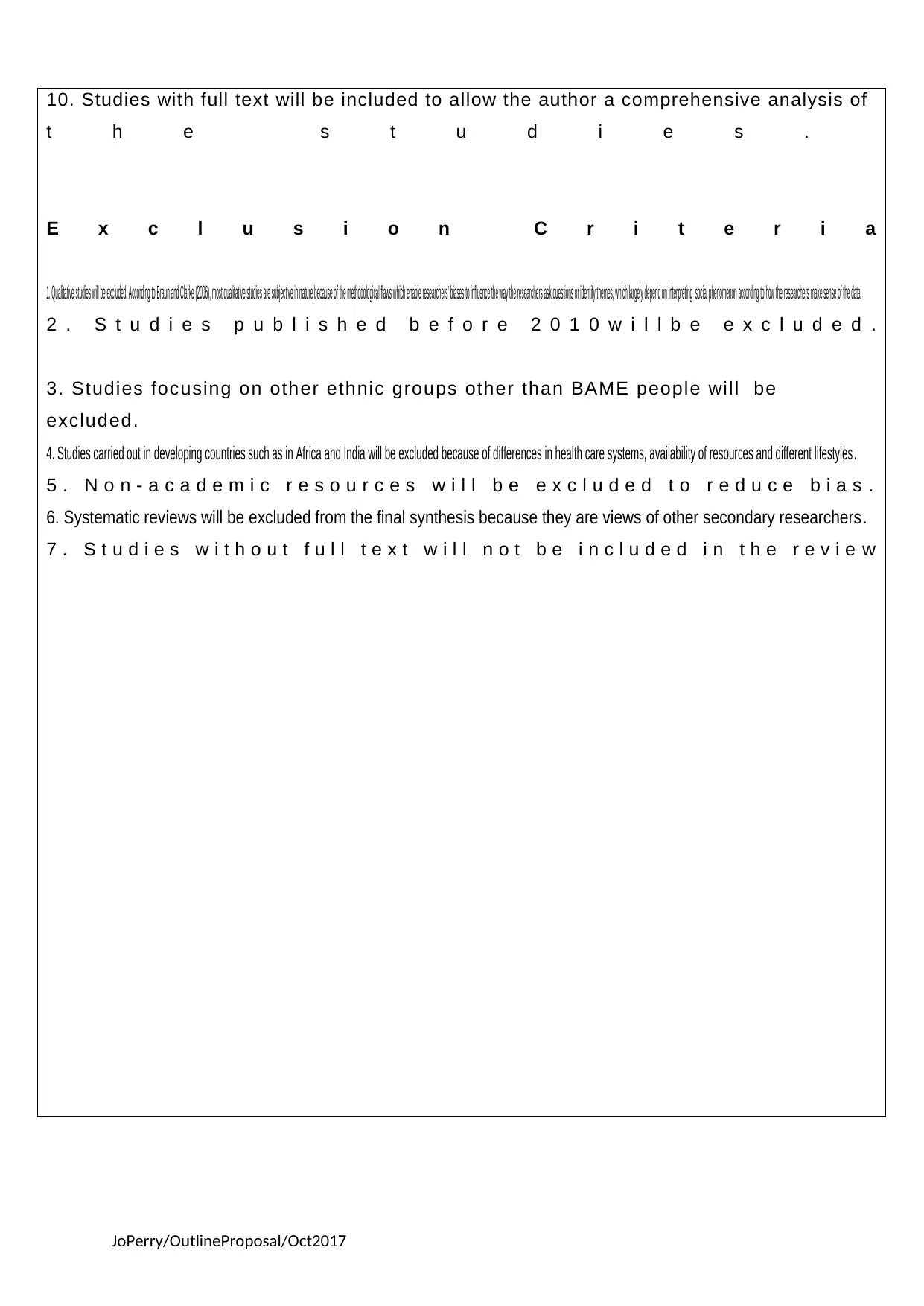
10. Studies with full text will be included to allow the author a comprehensive analysis of
t h e s t u d i e s .
E x c l u s i o n C r i t e r i a
1. Qualitative studies will be excluded. According to Braun and Clarke (2006), most qualitative studies are subjective in nature because of the methodological flaws which enable researchers’ biases to influence the way the researchers ask questions or identify themes, which largely depend on interpreting social phenomenon according to how the researchers make sense of the data.
2 . S t u d i e s p u b l i s h e d b e f o r e 2 0 1 0 w i l l b e e x c l u d e d .
3. Studies focusing on other ethnic groups other than BAME people will be
excluded.
4. Studies carried out in developing countries such as in Africa and India will be excluded because of differences in health care systems, availability of resources and different lifestyles .
5 . N o n - a c a d e m i c r e s o u r c e s w i l l b e e x c l u d e d t o r e d u c e b i a s .
6. Systematic reviews will be excluded from the final synthesis because they are views of other secondary researchers.
7 . S t u d i e s w i t h o u t f u l l t e x t w i l l n o t b e i n c l u d e d i n t h e r e v i e w
JoPerry/OutlineProposal/Oct2017
t h e s t u d i e s .
E x c l u s i o n C r i t e r i a
1. Qualitative studies will be excluded. According to Braun and Clarke (2006), most qualitative studies are subjective in nature because of the methodological flaws which enable researchers’ biases to influence the way the researchers ask questions or identify themes, which largely depend on interpreting social phenomenon according to how the researchers make sense of the data.
2 . S t u d i e s p u b l i s h e d b e f o r e 2 0 1 0 w i l l b e e x c l u d e d .
3. Studies focusing on other ethnic groups other than BAME people will be
excluded.
4. Studies carried out in developing countries such as in Africa and India will be excluded because of differences in health care systems, availability of resources and different lifestyles .
5 . N o n - a c a d e m i c r e s o u r c e s w i l l b e e x c l u d e d t o r e d u c e b i a s .
6. Systematic reviews will be excluded from the final synthesis because they are views of other secondary researchers.
7 . S t u d i e s w i t h o u t f u l l t e x t w i l l n o t b e i n c l u d e d i n t h e r e v i e w
JoPerry/OutlineProposal/Oct2017
⊘ This is a preview!⊘
Do you want full access?
Subscribe today to unlock all pages.

Trusted by 1+ million students worldwide
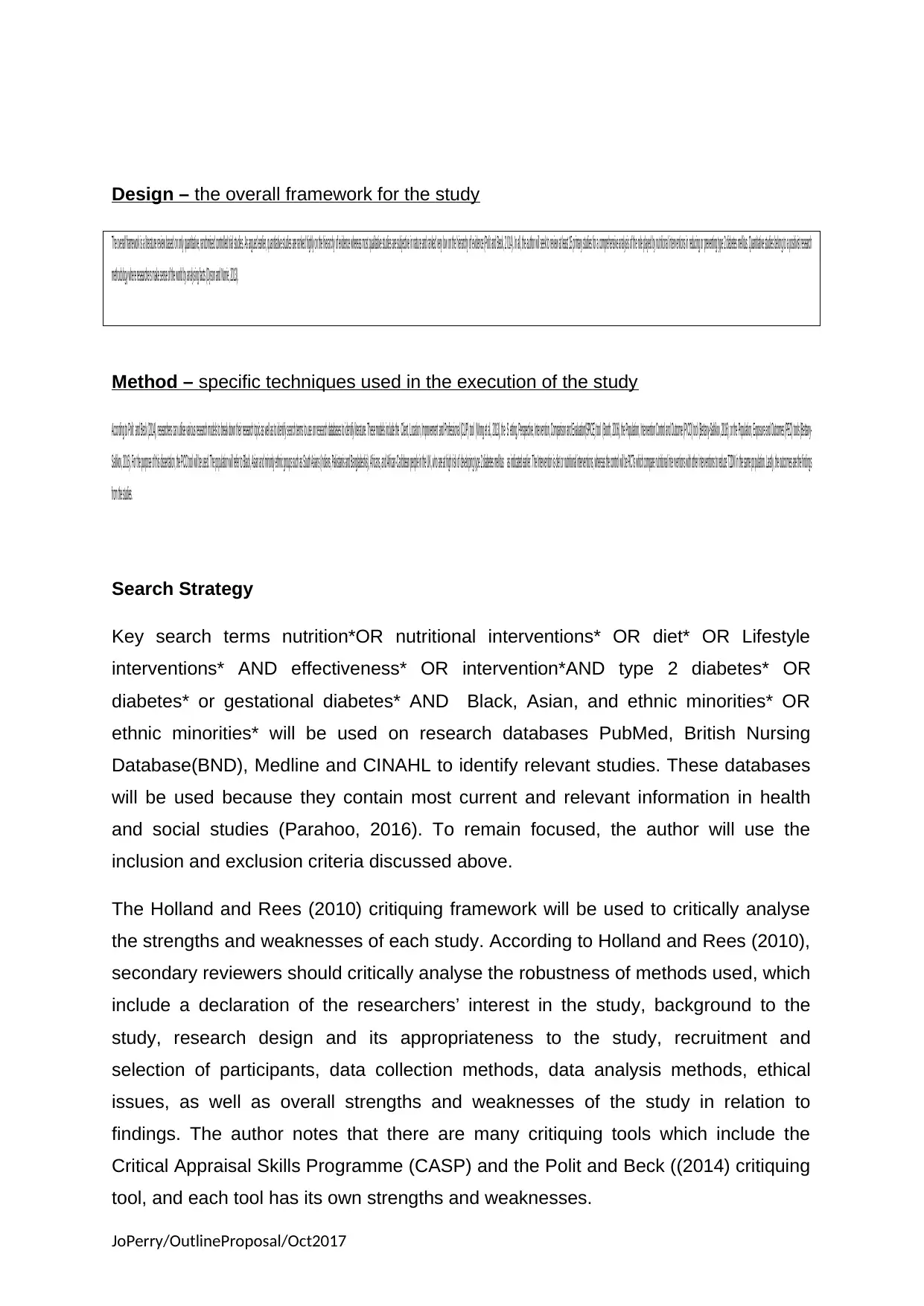
Design – the overall framework for the study
The overall framework is a literature review based on only quantitative, randomised controlled trial studies. As argued earlier, quantitative studies are ranked highly on the hierarchy of evidence whereas most qualitative studies are subjective in nature and ranked very low on the hierarchy of evidence (Polit and Beck, 2 014). In all, the author will seek to review at least 15 primary studies for a comprehensive analysis of the role played by nutritional interv entions in reducing or preventing type 2 diabetes mellitus. Quantitative studies belong to a positivist research
methodology where researchers make sense of the world by analysing facts (Dyson and Norrie, 2013).
Method – specific techniques used in the execution of the study
According to Polit and Beck (2014), researchers can utilise various research models to break down their research topic as well as to identify search terms to use on research databases to identify literature. These models include the Client, Location, Improvement and Professional (CLIP) tool (Wong et al., 2013), the S etting, Perspective, Intervention, Comparison and Evaluation(SPICE) tool (Booth, 2006), the Population, Intervention Control and Outcome (PI CO) tool (Bettany-Saltikov, 2016); or the Population, Exposure and Outcomes (PEO) tools (Bettany-
Saltikov, 2016). For the purpose of this dissertation, the PICO tool will be used. The population will refer to Black, Asian and minority ethnic groups such as South Asians (Indians, Pakistanis and Bangladeshis), Africans, and African-Caribbean people in the UK, who are at high risk of developing type 2 diabetes mellitus as indicated earlier. The Intervention is diet or nutritional interventions, whereas the control will be RCTs which compare nutritional inte rventions with other interventions to reduce T2DM in the same po pulation. Lastly, the outcomes are the findings
from the studies.
Search Strategy
Key search terms nutrition*OR nutritional interventions* OR diet* OR Lifestyle
interventions* AND effectiveness* OR intervention*AND type 2 diabetes* OR
diabetes* or gestational diabetes* AND Black, Asian, and ethnic minorities* OR
ethnic minorities* will be used on research databases PubMed, British Nursing
Database(BND), Medline and CINAHL to identify relevant studies. These databases
will be used because they contain most current and relevant information in health
and social studies (Parahoo, 2016). To remain focused, the author will use the
inclusion and exclusion criteria discussed above.
The Holland and Rees (2010) critiquing framework will be used to critically analyse
the strengths and weaknesses of each study. According to Holland and Rees (2010),
secondary reviewers should critically analyse the robustness of methods used, which
include a declaration of the researchers’ interest in the study, background to the
study, research design and its appropriateness to the study, recruitment and
selection of participants, data collection methods, data analysis methods, ethical
issues, as well as overall strengths and weaknesses of the study in relation to
findings. The author notes that there are many critiquing tools which include the
Critical Appraisal Skills Programme (CASP) and the Polit and Beck ((2014) critiquing
tool, and each tool has its own strengths and weaknesses.
JoPerry/OutlineProposal/Oct2017
The overall framework is a literature review based on only quantitative, randomised controlled trial studies. As argued earlier, quantitative studies are ranked highly on the hierarchy of evidence whereas most qualitative studies are subjective in nature and ranked very low on the hierarchy of evidence (Polit and Beck, 2 014). In all, the author will seek to review at least 15 primary studies for a comprehensive analysis of the role played by nutritional interv entions in reducing or preventing type 2 diabetes mellitus. Quantitative studies belong to a positivist research
methodology where researchers make sense of the world by analysing facts (Dyson and Norrie, 2013).
Method – specific techniques used in the execution of the study
According to Polit and Beck (2014), researchers can utilise various research models to break down their research topic as well as to identify search terms to use on research databases to identify literature. These models include the Client, Location, Improvement and Professional (CLIP) tool (Wong et al., 2013), the S etting, Perspective, Intervention, Comparison and Evaluation(SPICE) tool (Booth, 2006), the Population, Intervention Control and Outcome (PI CO) tool (Bettany-Saltikov, 2016); or the Population, Exposure and Outcomes (PEO) tools (Bettany-
Saltikov, 2016). For the purpose of this dissertation, the PICO tool will be used. The population will refer to Black, Asian and minority ethnic groups such as South Asians (Indians, Pakistanis and Bangladeshis), Africans, and African-Caribbean people in the UK, who are at high risk of developing type 2 diabetes mellitus as indicated earlier. The Intervention is diet or nutritional interventions, whereas the control will be RCTs which compare nutritional inte rventions with other interventions to reduce T2DM in the same po pulation. Lastly, the outcomes are the findings
from the studies.
Search Strategy
Key search terms nutrition*OR nutritional interventions* OR diet* OR Lifestyle
interventions* AND effectiveness* OR intervention*AND type 2 diabetes* OR
diabetes* or gestational diabetes* AND Black, Asian, and ethnic minorities* OR
ethnic minorities* will be used on research databases PubMed, British Nursing
Database(BND), Medline and CINAHL to identify relevant studies. These databases
will be used because they contain most current and relevant information in health
and social studies (Parahoo, 2016). To remain focused, the author will use the
inclusion and exclusion criteria discussed above.
The Holland and Rees (2010) critiquing framework will be used to critically analyse
the strengths and weaknesses of each study. According to Holland and Rees (2010),
secondary reviewers should critically analyse the robustness of methods used, which
include a declaration of the researchers’ interest in the study, background to the
study, research design and its appropriateness to the study, recruitment and
selection of participants, data collection methods, data analysis methods, ethical
issues, as well as overall strengths and weaknesses of the study in relation to
findings. The author notes that there are many critiquing tools which include the
Critical Appraisal Skills Programme (CASP) and the Polit and Beck ((2014) critiquing
tool, and each tool has its own strengths and weaknesses.
JoPerry/OutlineProposal/Oct2017
Paraphrase This Document
Need a fresh take? Get an instant paraphrase of this document with our AI Paraphraser
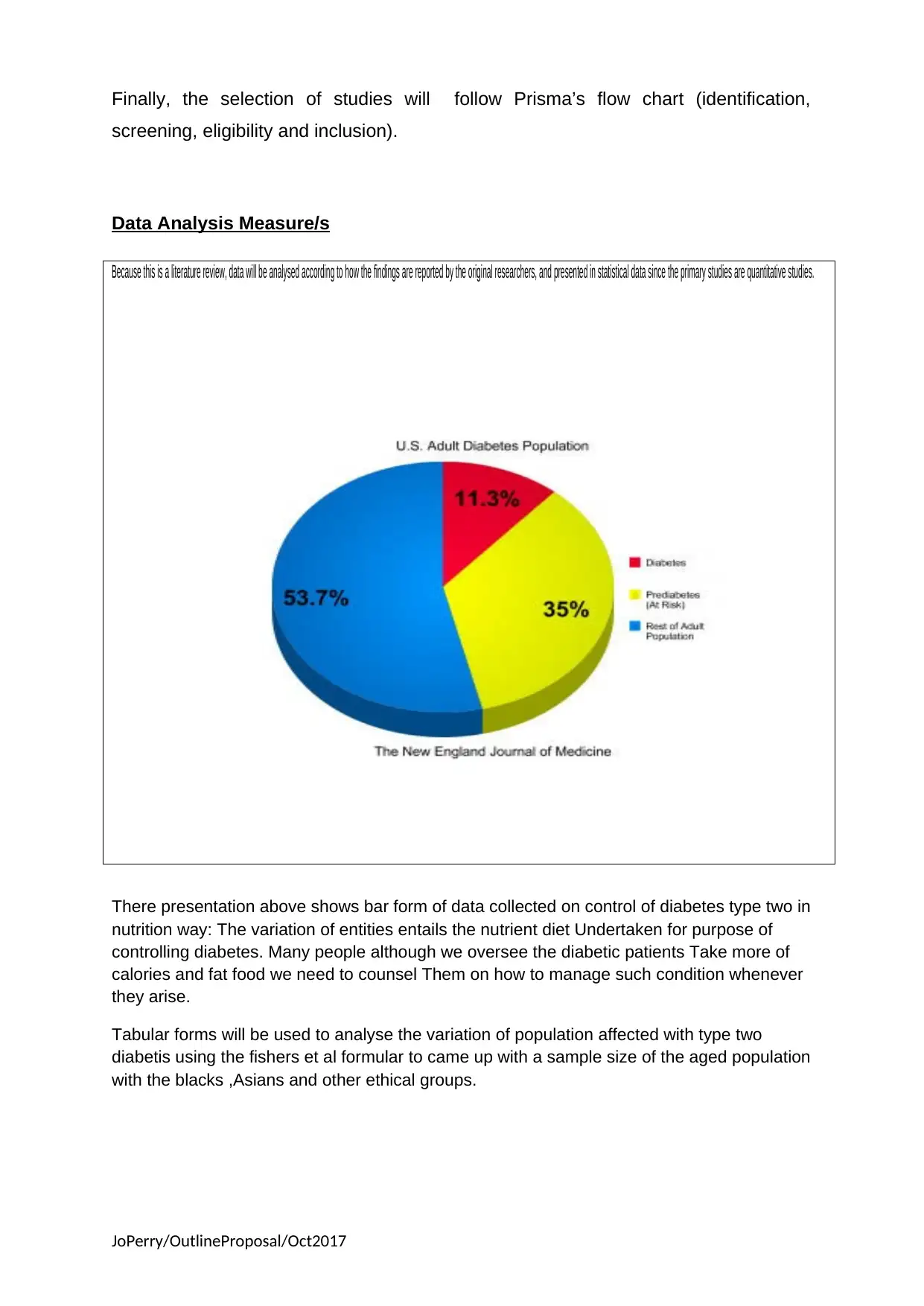
Finally, the selection of studies will follow Prisma’s flow chart (identification,
screening, eligibility and inclusion).
Data Analysis Measure/s
Because this is a literature review, data will be analysed according to how the findings are reported by the original researchers, and presented in statistical data since the primary studies are quantitative studies.
There presentation above shows bar form of data collected on control of diabetes type two in
nutrition way: The variation of entities entails the nutrient diet Undertaken for purpose of
controlling diabetes. Many people although we oversee the diabetic patients Take more of
calories and fat food we need to counsel Them on how to manage such condition whenever
they arise.
Tabular forms will be used to analyse the variation of population affected with type two
diabetis using the fishers et al formular to came up with a sample size of the aged population
with the blacks ,Asians and other ethical groups.
JoPerry/OutlineProposal/Oct2017
screening, eligibility and inclusion).
Data Analysis Measure/s
Because this is a literature review, data will be analysed according to how the findings are reported by the original researchers, and presented in statistical data since the primary studies are quantitative studies.
There presentation above shows bar form of data collected on control of diabetes type two in
nutrition way: The variation of entities entails the nutrient diet Undertaken for purpose of
controlling diabetes. Many people although we oversee the diabetic patients Take more of
calories and fat food we need to counsel Them on how to manage such condition whenever
they arise.
Tabular forms will be used to analyse the variation of population affected with type two
diabetis using the fishers et al formular to came up with a sample size of the aged population
with the blacks ,Asians and other ethical groups.
JoPerry/OutlineProposal/Oct2017
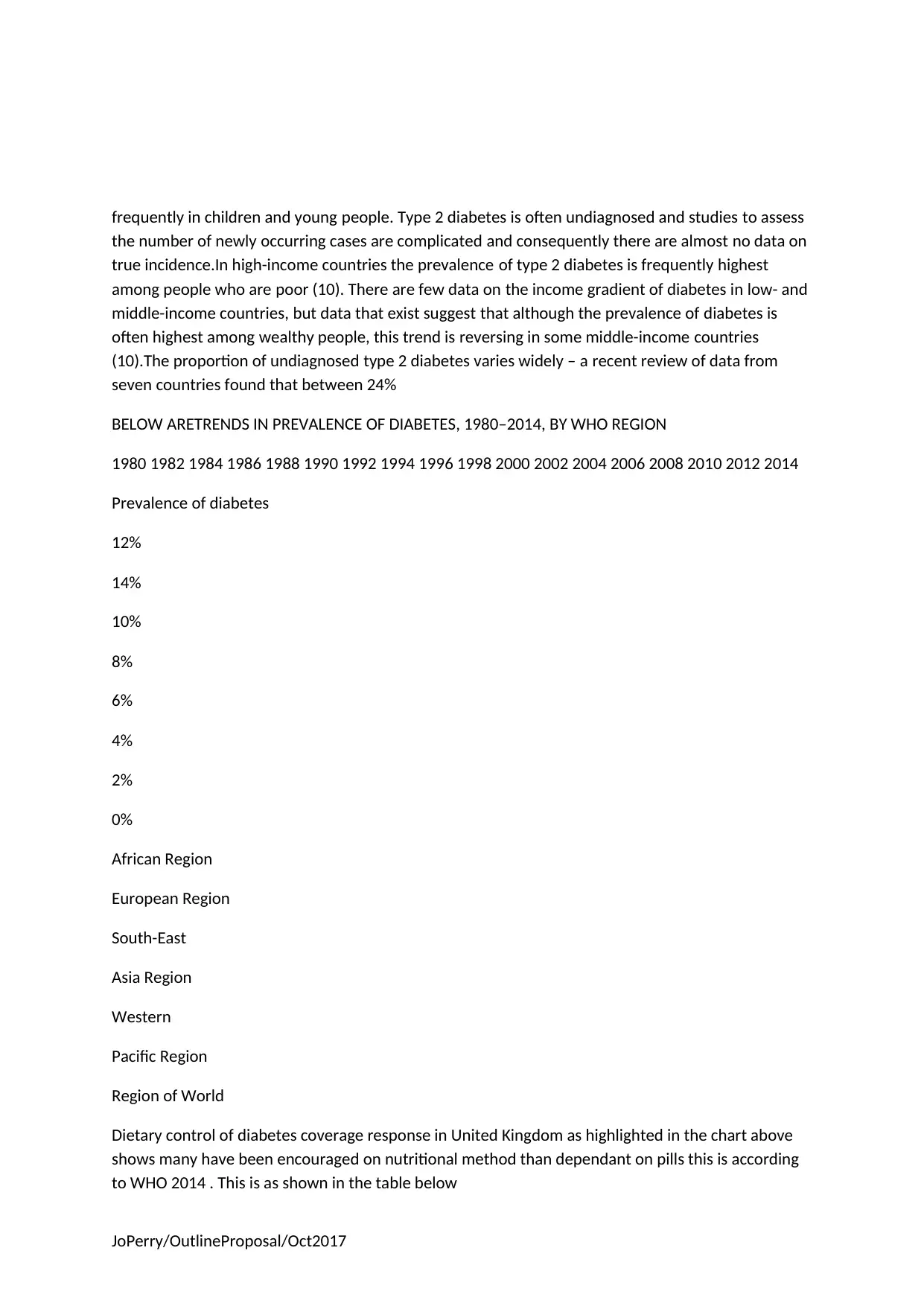
frequently in children and young people. Type 2 diabetes is often undiagnosed and studies to assess
the number of newly occurring cases are complicated and consequently there are almost no data on
true incidence.In high-income countries the prevalence of type 2 diabetes is frequently highest
among people who are poor (10). There are few data on the income gradient of diabetes in low- and
middle-income countries, but data that exist suggest that although the prevalence of diabetes is
often highest among wealthy people, this trend is reversing in some middle-income countries
(10).The proportion of undiagnosed type 2 diabetes varies widely – a recent review of data from
seven countries found that between 24%
BELOW ARETRENDS IN PREVALENCE OF DIABETES, 1980–2014, BY WHO REGION
1980 1982 1984 1986 1988 1990 1992 1994 1996 1998 2000 2002 2004 2006 2008 2010 2012 2014
Prevalence of diabetes
12%
14%
10%
8%
6%
4%
2%
0%
African Region
European Region
South-East
Asia Region
Western
Pacific Region
Region of World
Dietary control of diabetes coverage response in United Kingdom as highlighted in the chart above
shows many have been encouraged on nutritional method than dependant on pills this is according
to WHO 2014 . This is as shown in the table below
JoPerry/OutlineProposal/Oct2017
the number of newly occurring cases are complicated and consequently there are almost no data on
true incidence.In high-income countries the prevalence of type 2 diabetes is frequently highest
among people who are poor (10). There are few data on the income gradient of diabetes in low- and
middle-income countries, but data that exist suggest that although the prevalence of diabetes is
often highest among wealthy people, this trend is reversing in some middle-income countries
(10).The proportion of undiagnosed type 2 diabetes varies widely – a recent review of data from
seven countries found that between 24%
BELOW ARETRENDS IN PREVALENCE OF DIABETES, 1980–2014, BY WHO REGION
1980 1982 1984 1986 1988 1990 1992 1994 1996 1998 2000 2002 2004 2006 2008 2010 2012 2014
Prevalence of diabetes
12%
14%
10%
8%
6%
4%
2%
0%
African Region
European Region
South-East
Asia Region
Western
Pacific Region
Region of World
Dietary control of diabetes coverage response in United Kingdom as highlighted in the chart above
shows many have been encouraged on nutritional method than dependant on pills this is according
to WHO 2014 . This is as shown in the table below
JoPerry/OutlineProposal/Oct2017
⊘ This is a preview!⊘
Do you want full access?
Subscribe today to unlock all pages.

Trusted by 1+ million students worldwide

JoPerry/OutlineProposal/Oct2017
Paraphrase This Document
Need a fresh take? Get an instant paraphrase of this document with our AI Paraphraser
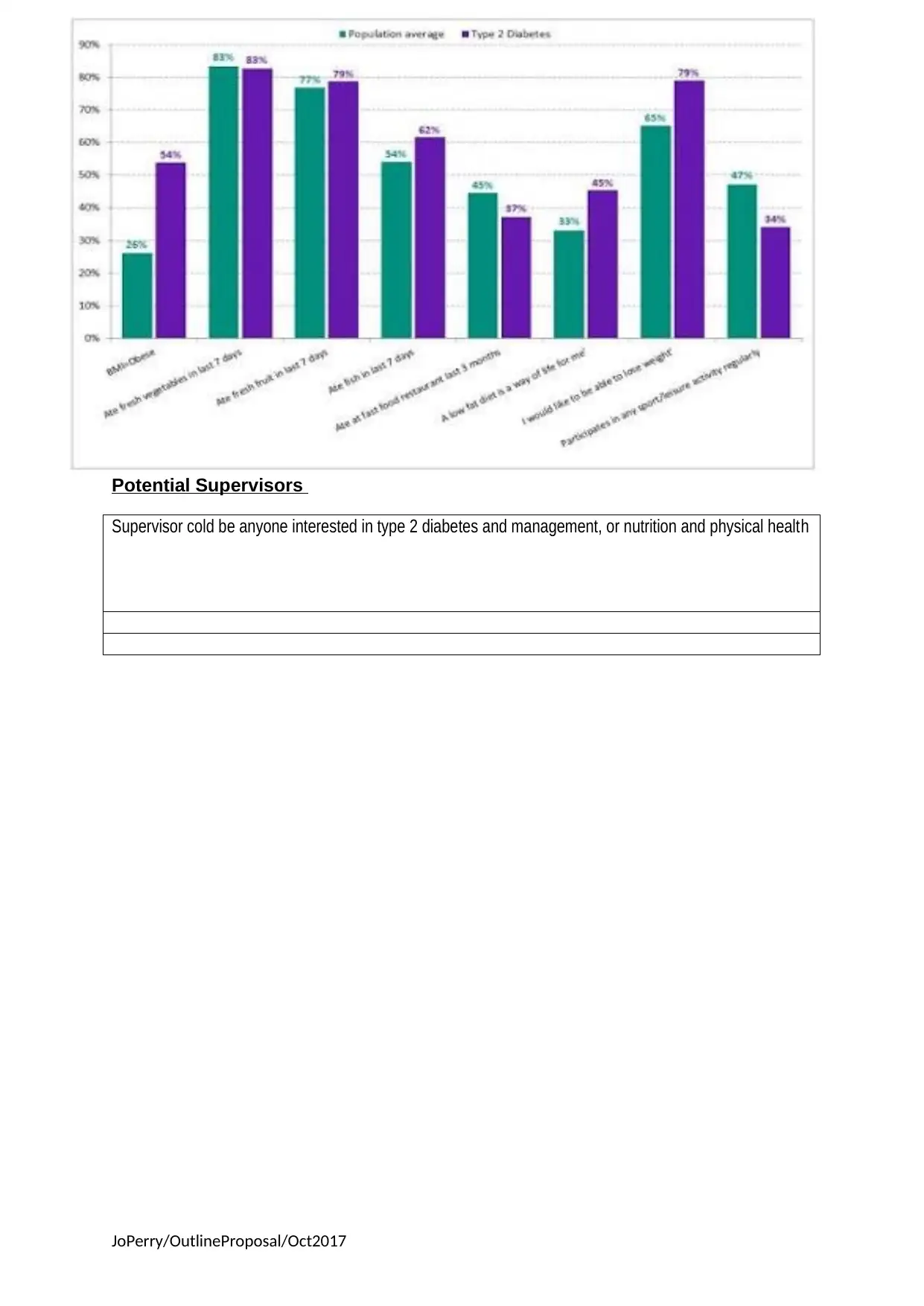
Potential Supervisors
Supervisor cold be anyone interested in type 2 diabetes and management, or nutrition and physical health
JoPerry/OutlineProposal/Oct2017
Supervisor cold be anyone interested in type 2 diabetes and management, or nutrition and physical health
JoPerry/OutlineProposal/Oct2017
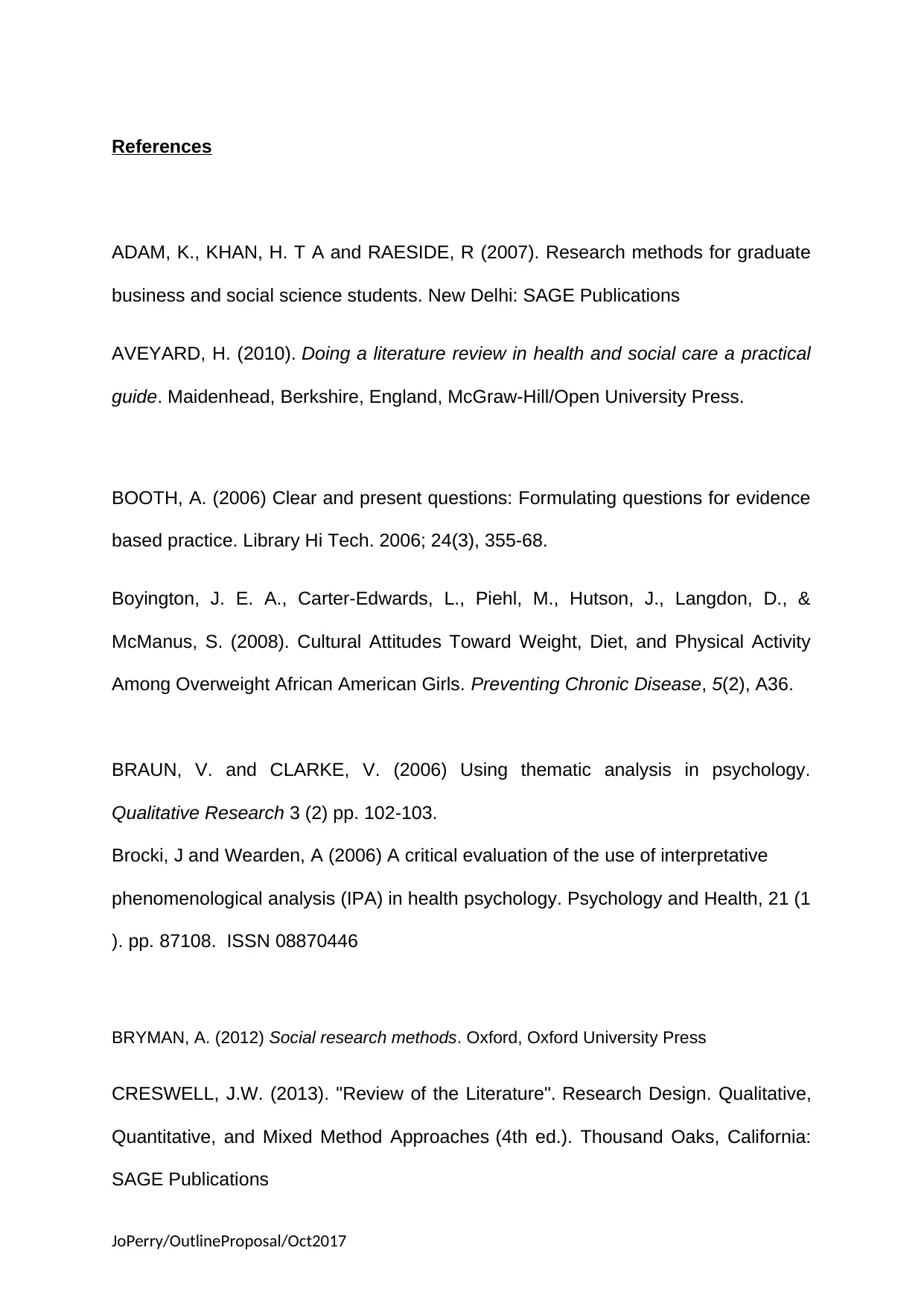
References
ADAM, K., KHAN, H. T A and RAESIDE, R (2007). Research methods for graduate
business and social science students. New Delhi: SAGE Publications
AVEYARD, H. (2010). Doing a literature review in health and social care a practical
guide. Maidenhead, Berkshire, England, McGraw-Hill/Open University Press.
BOOTH, A. (2006) Clear and present questions: Formulating questions for evidence
based practice. Library Hi Tech. 2006; 24(3), 355-68.
Boyington, J. E. A., Carter-Edwards, L., Piehl, M., Hutson, J., Langdon, D., &
McManus, S. (2008). Cultural Attitudes Toward Weight, Diet, and Physical Activity
Among Overweight African American Girls. Preventing Chronic Disease, 5(2), A36.
BRAUN, V. and CLARKE, V. (2006) Using thematic analysis in psychology.
Qualitative Research 3 (2) pp. 102-103.
Brocki, J and Wearden, A (2006) A critical evaluation of the use of interpretative
phenomenological analysis (IPA) in health psychology. Psychology and Health, 21 (1
). pp. 87108. ISSN 08870446
BRYMAN, A. (2012) Social research methods. Oxford, Oxford University Press
CRESWELL, J.W. (2013). "Review of the Literature". Research Design. Qualitative,
Quantitative, and Mixed Method Approaches (4th ed.). Thousand Oaks, California:
SAGE Publications
JoPerry/OutlineProposal/Oct2017
ADAM, K., KHAN, H. T A and RAESIDE, R (2007). Research methods for graduate
business and social science students. New Delhi: SAGE Publications
AVEYARD, H. (2010). Doing a literature review in health and social care a practical
guide. Maidenhead, Berkshire, England, McGraw-Hill/Open University Press.
BOOTH, A. (2006) Clear and present questions: Formulating questions for evidence
based practice. Library Hi Tech. 2006; 24(3), 355-68.
Boyington, J. E. A., Carter-Edwards, L., Piehl, M., Hutson, J., Langdon, D., &
McManus, S. (2008). Cultural Attitudes Toward Weight, Diet, and Physical Activity
Among Overweight African American Girls. Preventing Chronic Disease, 5(2), A36.
BRAUN, V. and CLARKE, V. (2006) Using thematic analysis in psychology.
Qualitative Research 3 (2) pp. 102-103.
Brocki, J and Wearden, A (2006) A critical evaluation of the use of interpretative
phenomenological analysis (IPA) in health psychology. Psychology and Health, 21 (1
). pp. 87108. ISSN 08870446
BRYMAN, A. (2012) Social research methods. Oxford, Oxford University Press
CRESWELL, J.W. (2013). "Review of the Literature". Research Design. Qualitative,
Quantitative, and Mixed Method Approaches (4th ed.). Thousand Oaks, California:
SAGE Publications
JoPerry/OutlineProposal/Oct2017
⊘ This is a preview!⊘
Do you want full access?
Subscribe today to unlock all pages.

Trusted by 1+ million students worldwide
1 out of 16
Related Documents
Your All-in-One AI-Powered Toolkit for Academic Success.
+13062052269
info@desklib.com
Available 24*7 on WhatsApp / Email
![[object Object]](/_next/static/media/star-bottom.7253800d.svg)
Unlock your academic potential
Copyright © 2020–2025 A2Z Services. All Rights Reserved. Developed and managed by ZUCOL.



